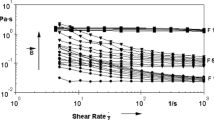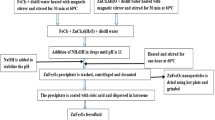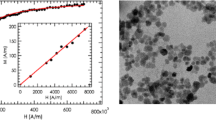Abstract
In this paper, the magnetorheological (MR) and magnetoviscous properties of ferrofluid-based iron particle suspensions were investigated. The 2.1-µm mean size Fe particles were dispersed in high-concentration transformer oil-based ferrofluid, the iron particle volume fraction in the resulting nano-micro composite magnetorheological fluid samples varying from Φ Fe = 5 to 40 %. The ferrofluid carrier has φ p = 23 % solid volume fraction of magnetic nanoparticles stabilized with chemisorbed oleic acid monolayer and without any excess surfactant. In the absence of the field, the ferrofluid has a quasi-Newtonian behavior with a weak shear thinning tendency. The static yield stress shows an increase of about 3 orders of magnitude for an iron particle content of approx. Φ Fe = 25 % (Φ tot = 42.25 %), while above this value, a saturation tendency is observed. The dynamic yield stress (Bingham model) also increases with the magnetic induction and the particle volume fraction; however, the saturation of the MR effect is less pronounced. The relative viscosity change has a maximum at Φ Fe = (10–15) % due to the accelerated increase of the effective viscosity of the composite for higher Fe content. Addition of micrometer-sized iron particles to a concentrated ferrofluid without any supplementary stabilizing agent proved to be a direct and simple way to control the magnetorheological and magnetoviscous behavior, as well as the saturation magnetization of the resulting nano-micro composite fluid to fulfill the requirements of their use in various MR control and rotating seal devices.







Similar content being viewed by others
References
Bica D, Potencz I, Vékás L, Giula G, Potra F (2000) Romanian Patent RO 115533B1
Bica D, Vékás L, Balanean F, Borbáth I, Boros T, Gálffy D (2009) Romanian Patent RO 122725-B1
Borbáth T, Bica D, Potencz I, Borbáth I, Boros T, Vékás L (2011) Leakage-free rotating seal systems with magnetic nanofluids and magnetic composite fluids designed for various applications. Int J Fluid Mach Syst 4(1):67–75. doi:10.5293/IJFMS.2011.4.1.067
Bossis G, Volkova O, Lacis S, Meunier A (2002) Magnetorheology: fluids, structures and rheology. In: Odenbach S (ed) Ferrofluids. Magnetically controllable fluids and their applications (Lecture notes in physics; 594; Springer, Heidelberg 2002), pp 202– 230
Carlson JD, Jolly M R (2000) MR Fluid, foam and elastomer devices. Mechatronics 10:555–569
Ginder JM, Elie LD, Davies LC (1996) US Patent 5549837
Goncalves FD, Koo J-H, Ahmadian M (2006) A review of the state of the art in magnetorheological fluid technologies-Part I: MR fluid and MR fluid models. Shock Vib Dig 38:203–219
Iglesias GR, López-López MT, Durán JDG, González-Caballero F, Delgado AV (2012) Dynamic characterization of extremely bidisperse magnetorheological fluids. J Coll Interface Sci 377:153–159
Klingenberg DJ (2001) Magnetorheology: applications and challenges. AIChE J 47(2):246–249
Klingenberg DJ, Ulicny JC, Golden MA (2007) Mason numbers for magnetorheology. J Rheol 51(5):883–893
Kordonski WI, Gorodkin SR, Novikova Z-A (1997) The influence of ferroparticle concentration and size on MR fluid properties. In: Proc. 6th Int. Conf. electrorheological fluids and magnetorheological suspensions and their applications, Yonezawa, Japan (22-25 July 1997) pp 532–542
López-López MT, de Vicente J, Bossis G, González-Caballero F, Durán JDG (2005) Preparation of stable magnetorheological fluids based on extremely bimodal iron–magnetite suspensions. J Mater Res 20(4):874–881
López-López MT, Kuzhir P, Lacis S, Bossis G, González-Caballero F, Durán JDG (2006) Magnetorheology for suspensions of solid particles dispersed in ferrofluids. J Phys: Condens Matter 18:S2803–S2813
Lopez-Lopez MT, Bossis G, Duran JDG, Gomez-Ramirez A, Kuzhir P, Iskakova L, Zubarev A Yu (2013) Inversion of magnetic forces between microparticles and its effect on the magnetorheology of extremely bidisperse magnetic fluids. J Nanofluids 2:85–93
Magnet C, Kuzhir P, Bossis G, Meunier A, Suloeva L, Zubarev A (2012) Haloing in bimodal magnetic colloids: the role of field induced phase separation. Phys Rev E 86:011–404 (18 p)
Man W, Donev A, Stillinger FH, Sullivan MT, Russel WB, Heeger D, Inati S, Torquato S, Chaikin PM (2005) Experiments on random packings of ellipsoids. Phys Rev Lett 94(19):198–001 (4p)
Odenbach S, Thurm S Magnetoviscous Effects in Ferrofluids. In: Odenbach S (ed) Ferrofluids. Magnetically controllable fluids and their applications (Lecture notes in physics; 594; Springer-Heidelberg 2002), pp 186–201
Park BJ, Fang FF, Choi HJ (2010) Magnetorheology: materials and application. Soft Matter 6:5246–5253
Patel R (2011) Mechanism of chain formation in nanofluid based MR fluids. J Magn Magn Mater 323:1360–1363
Rosensweig RE (1985) Ferrohydrodynamics, Cambridge University Press:344
Shah K, Upadhyay RV, Aswal VK (2012) Influence of large size magnetic particles on the magneto-viscous properties of ferrofluid. Smart Mater Struct 21:1–13
Susan-Resiga D, Bica D, Vékás L (2010) Flow behaviour of extremely bidisperse magnetizable fluids. J Magn Magn Mater 322:3166–3172
Susan-Resiga D, Socoliuc V, Boros T, Borbáth T, Marinica O, Han A, Vékás L (2012) The influence of particle clustering on the rheological properties of highly concentrated magnetic nanofluids. J Coll Interface Sci 373:110–115
Vékás L (2008) Ferrofluids and magnetorheological fluids (review). Adv Sci Technol 54:127–136
de Vicente J, Klingenberg DJ, Hidalgo-Álvarez R (2011) Magnetorheological fluids: a review. Soft Matter 7:3701–3710
Viota JL, Gonzalez-Caballero F, Duran JDG, Delgado AV (2007) Study of the colloidal stability of concentrated bimodal magnetic fluids. J Coll Interface Sci 309:135–139
Wang X, Gordaninejad F (2006) Study of magnetorheological fluids at high shear rates. Rheol Acta 45:899–908
Wollny K, Läuger J, Huck S (2002) Magneto sweep—a new method for characterizing the viscoelastic properties of magneto-rheological fluids. Appl Rheol 12(1):25–31
Yang Y, Li L, Chen G (2009) Static yield stress of ferrofluid-based magnetorheological fluids. Rheol Acta 48:457–466
Acknowledgments
This work was supported by the MagNanoMicroSeal research project (contract no. 157/2012-PNII-UEFISCDI) and by the Research Program LLM-CCTFA 2013–2015 of the Romanian Academy. The concentrated ferrofluid carrier and the nano-micro composite MR fluid samples were provided by ROSEAL Co. Odorheiu Secuiesc (Romania). The critical comments and helpful suggestions of the referee(s) are gratefully acknowledged. The authors are indebted to Dipl.-Phys. Oana Marinica, PhD fellow, for the VSM measurements of the magnetizable fluid samples. Many thanks are due to Dr. Vlad Socoliuc for fruitful discussions.
Author information
Authors and Affiliations
Corresponding author
Rights and permissions
About this article
Cite this article
Susan-Resiga, D., Vékás, L. Yield stress and flow behavior of concentrated ferrofluid-based magnetorheological fluids: the influence of composition. Rheol Acta 53, 645–653 (2014). https://doi.org/10.1007/s00397-014-0785-z
Received:
Revised:
Accepted:
Published:
Issue Date:
DOI: https://doi.org/10.1007/s00397-014-0785-z




